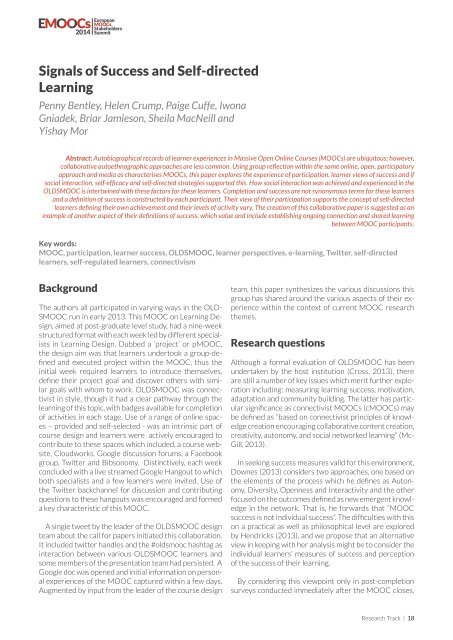zmWmQs
zmWmQs
zmWmQs
Create successful ePaper yourself
Turn your PDF publications into a flip-book with our unique Google optimized e-Paper software.
Signals of Success and Self-directed<br />
Learning<br />
Penny Bentley, Helen Crump, Paige Cuffe, Iwona<br />
Gniadek, Briar Jamieson, Sheila MacNeill and<br />
Yishay Mor<br />
Abstract: Autobiographical records of learner experiences in Massive Open Online Courses (MOOCs) are ubiquitous; however,<br />
collaborative autoethnographic approaches are less common. Using group reflection within the same online, open, participatory<br />
approach and media as characterises MOOCs, this paper explores the experience of participation, learner views of success and if<br />
social interaction, self-efficacy and self-directed strategies supported this. How social interaction was achieved and experienced in the<br />
OLDSMOOC is intertwined with these factors for these learners. Completion and success are not synonymous terms for these learners<br />
and a definition of success is constructed by each participant. Their view of their participation supports the concept of self-directed<br />
learners defining their own achievement and their levels of activity vary. The creation of this collaborative paper is suggested as an<br />
example of another aspect of their definitions of success, which value and include establishing ongoing connection and shared learning<br />
between MOOC participants.<br />
Key words:<br />
MOOC, participation, learner success, OLDSMOOC, learner perspectives, e-learning, Twitter, self-directed<br />
learners, self-regulated learners, connectivism<br />
Background<br />
The authors all participated in varying ways in the OLD-<br />
SMOOC run in early 2013. This MOOC on Learning Design,<br />
aimed at post-graduate level study, had a nine-week<br />
structured format with each week led by different specialists<br />
in Learning Design. Dubbed a ‘project’ or pMOOC,<br />
the design aim was that learners undertook a group-defined<br />
and executed project within the MOOC, thus the<br />
initial week required learners to introduce themselves,<br />
define their project goal and discover others with similar<br />
goals with whom to work. OLDSMOOC was connectivist<br />
in style, though it had a clear pathway through the<br />
learning of this topic, with badges available for completion<br />
of activities in each stage. Use of a range of online spaces<br />
– provided and self-selected - was an intrinsic part of<br />
course design and learners were actively encouraged to<br />
contribute to these spaces which included, a course website,<br />
Cloudworks, Google discussion forums, a Facebook<br />
group, Twitter and Bibsonomy. Distinctively, each week<br />
concluded with a live streamed Google Hangout to which<br />
both specialists and a few learners were invited. Use of<br />
the Twitter backchannel for discussion and contributing<br />
questions to these hangouts was encouraged and formed<br />
a key characteristic of this MOOC.<br />
A single tweet by the leader of the OLDSMOOC design<br />
team about the call for papers initiated this collaboration.<br />
It included twitter handles and the #oldsmooc hashtag as<br />
interaction between various OLDSMOOC learners and<br />
some members of the presentation team had persisted. A<br />
Google doc was opened and initial information on personal<br />
experiences of the MOOC captured within a few days.<br />
Augmented by input from the leader of the course design<br />
team, this paper synthesizes the various discussions this<br />
group has shared around the various aspects of their experience<br />
within the context of current MOOC research<br />
themes.<br />
Research questions<br />
Although a formal evaluation of OLDSMOOC has been<br />
undertaken by the host institution (Cross, 2013), there<br />
are still a number of key issues which merit further exploration<br />
including: measuring learning success, motivation,<br />
adaptation and community building. The latter has particular<br />
significance as connectivist MOOCs (cMOOCs) may<br />
be defined as “based on connectivist principles of knowledge<br />
creation encouraging collaborative content creation,<br />
creativity, autonomy, and social networked learning” (Mc-<br />
Gill, 2013).<br />
In seeking success measures valid for this environment,<br />
Downes (2013) considers two approaches, one based on<br />
the elements of the process which he defines as Autonomy,<br />
Diversity, Openness and Interactivity and the other<br />
focused on the outcomes defined as new emergent knowledge<br />
in the network. That is, he forwards that “MOOC<br />
success is not individual success”. The difficulties with this<br />
on a practical as well as philosophical level are explored<br />
by Hendricks (2013), and we propose that an alternative<br />
view in keeping with her analysis might be to consider the<br />
individual learners’ measures of success and perception<br />
of the success of their learning.<br />
By considering this viewpoint only in post-completion<br />
surveys conducted immediately after the MOOC closes,<br />
Research Track | 18


